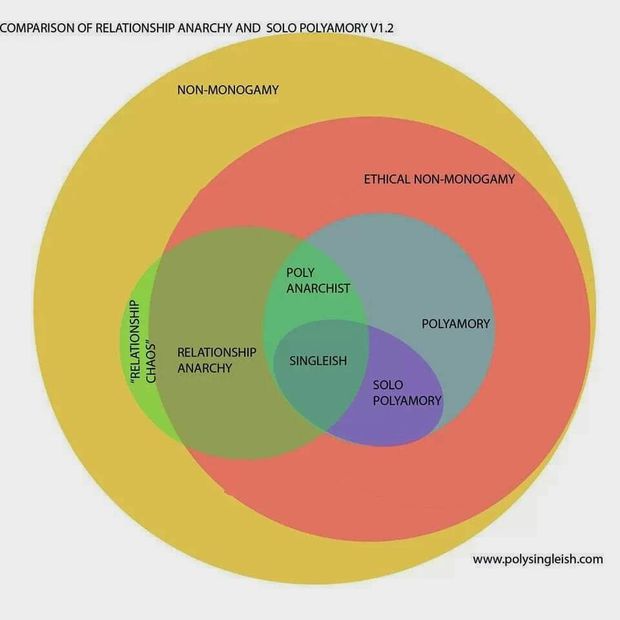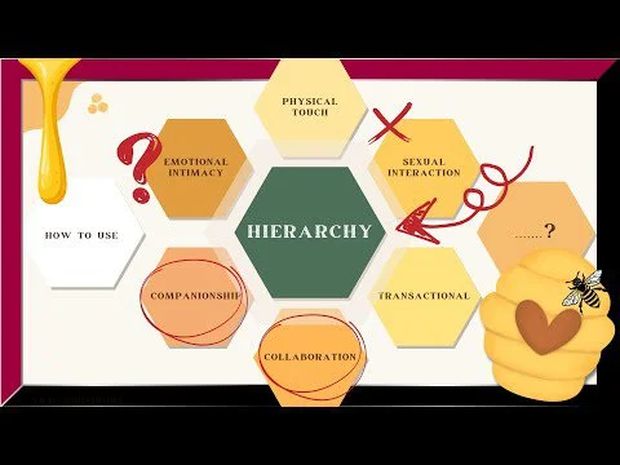It has already been established that a polyamorous relationship operates under the philosophy in which romantic and personal relationships have evolved to allow all the members involved to have several love and sexual connections simultaneously.

The original concept of monogamy, when understood in the context of amorous relationships, is in constant transformation and it has reached ways in which people can openly relate with other multiple partners and those partners can also openly relate with other partners or with only a few.
Other types of polyamory can involve a single individual who can openly relate with multiple romantic and sexual partners, what we know as solo poly (we will later define it a bit better) or partners can be involved in the ultimate open relationship where no rules are applied what is called relationship anarchy (will expand on this concept a bit better).
What is a solo poly and a relationship anarchy?
Solo poly, also known as solo polyamory or autonomous polyamory, is a relationship model in which an individual is committed to multiple romantic and/or sexual relationships without the need for a primary or hierarchical structure.
In a solo poly relationship, each person is responsible for their own emotional needs and is free to pursue and maintain relationships with others as they see fit, without the expectation of exclusivity or the need to seek permission or approval from their partners.
This model can be seen as a way of prioritising autonomy and agency within relationships, and it allows individuals to build their own unique network of connections and connections.

In contrast, relationship anarchy is a relationship model in which individuals view all of their relationships as equal.
Relationship anarchy (RA), a term coined by Andie Nordgren, describes a philosophy that suggests that all relationships, including romantic ones, should not be limited or governed by rules or expectations that have not been agreed upon by the people involved.
This approach’s background comes from the principles of political anarchy, which advocates for the absence of government or hierarchy in society.
The goal of relationship anarchy is to allow individuals to create relationships that are based on consent, communication, and personal growth, rather than being bound by traditional models or norms.
They prioritise personal growth, honesty, and communication over traditional relationship roles and expectations.
Relationship anarchy challenges the idea that certain relationships, such as romantic or familial relationships, should be given more value or importance than others.
Instead, individuals are free to create and maintain relationships with others in a way that works best for them, without the need to label or categorise those relationships.
Relationship anarchy can be seen as a way of rejecting traditional relationship hierarchy and norms in favour of creating more authentic and fulfilling connections with others.

Nordgren's ideas about relationship anarchy gained traction and sparked discussion and debate within the online community. This is particularly important for those who are interested and in need to seek out more information. There is a huge community online where you can build connections.
Those individuals seeking to pursue a relationship anarchy type of partnership should find these connections and also learn more about what is called “The Relationship Anarchy manifesto”.
The Relationship Anarchy manifesto is a document that outlines the principles, goals, and priorities of this relationship lifestyle and modus operandi.
The need for a Relationship Anarchy manifesto arises from the fact that people interested in this anarchy, felt that traditional models of relationships often failed to take into account the diverse needs and desires of individuals.
Those traditional and obsolete models are often based on outdated or oppressive ideas about gender, sexuality, and power dynamics, and can be limiting or even harmful for those who do not fit into them.
The Relationship Anarchy manifesto offers a way for individuals to create connections that are based on their own values and goals, rather than being dictated by societal norms. This is, by providing an alternative framework for relationships.

What are the differences between Solo Polyamory and Relationship Anarchy?
Here are some key differences between solo poly and relationship anarchy:
- Hierarchy: Solo poly relationships may have a primary/secondary structure, with some relationships taking priority over others, while relationship anarchy relationships are non-hierarchical, with all relationships considered equal.
- Exclusivity: Solo poly relationships may or may not be exclusive, depending on the individual and their partners, while relationship anarchy relationships do not prioritise exclusivity.
- Autonomy: Both solo poly and relationship anarchy prioritise personal autonomy and agency, allowing individuals to make their own decisions about their relationships without the need for outside approval or validation.
However, solo poly relationships may still involve some level of negotiation or communication with partners, while relationship anarchy often emphasises complete autonomy in all relationships. - Labelling: Solo poly relationships may or may not involve labels such as "partner" or "primary", while relationship anarchy partnerships generally reject labels and categorisation of their alliances.
- Fluid relationships: Relationship anarchy partnerships are generally more fluid, flexible and open to change, while solo poly relationships may be more fixed or structured.
- Communication: Both solo poly and relationship anarchy prioritise honesty and communication in relationships.
However, solo poly relationships may still involve some level of negotiation or communication with partners, while relationship anarchy often emphasises complete transparency and honesty in all relationships. - Personal growth: Both solo poly and relationship anarchy relationships prioritise personal growth, but relationship anarchy relationships may place more emphasis on this aspect.
- Traditional relationship roles: Solo poly relationships may incorporate traditional relationship roles to a greater extent, while relationship anarchy relationships reject traditional roles and expectations.
- Structure: Solo poly relationships typically lack a primary or hierarchical structure, with individuals free to pursue and maintain relationships with others as they see fit. Relationship anarchy, on the other hand, challenges traditional relationship roles and hierarchy, with all relationships considered equal.
- Exclusivity: Solo poly relationships may or may not be exclusive, with individuals free to engage in multiple relationships at the same time. Relationship anarchy, on the other hand, typically does not prioritise exclusivity, with individuals free to create and maintain relationships with others as they see fit.
What are the different types of solo poly and anarchy relationships?
There are several different types of solo poly relationships, including:
- Multi-partner relationships: These are relationships in which an individual is involved with multiple people at the same time, either romantically or sexually. These relationships can be open, with all partners aware of and consent to the involvement of others, or they can be more private and discrete.
- Solo non-monogamy: This is a type of solo poly relationship in which an individual engages in non-monogamous behaviour, such as casual dating or casual sexual encounters, without being part of a committed relationship with any one person.
- Networked solo poly: This is a type of solo poly relationship in which an individual is connected to a network of other solo poly individuals, rather than being part of a traditional monogamous or polyamorous relationship.
- Primary/secondary relationships: In this type of solo poly relationship, an individual may have one or more primary relationships that take priority, while other relationships are considered secondary. These secondary relationships may be less committed or may involve fewer emotional or logistical commitments.

There are several different types of relationship anarchy relationships, including:
- Non-hierarchical relationships: In a relationship anarchy model, all relationships are considered equal and there is no hierarchy or ranking of relationships. This means that individuals are free to prioritise their relationships in any way they choose, without the need to conform to traditional roles or expectations.
- Fluid relationships: Relationship anarchy allows for relationships to be fluid and change over time, rather than being fixed or static. Individuals are free to change the nature of their relationships as their needs and desires evolve.
- Autonomous relationships: Relationship anarchy emphasises personal autonomy and agency, allowing individuals to make their own decisions about their relationships without the need for outside approval or validation.
- Unlabelled relationships: In a relationship anarchy model, individuals are free to define their relationships in whatever way makes sense to them, without the need to label them as romantic, platonic, or familial.

Final Thoughts
In conclusion, solo poly and relationship anarchy are two distinct approaches to relationships and intimacy.
Solo poly relationships are mainly characterised by a lack of exclusivity, focusing instead on individual autonomy and agency within the context of multiple relationships.
Conversely, relationship anarchy, emphasises the equality of all relationships and the importance of personal growth, honesty, and communication.
Both models allow for fluid and changing relationships, being they, the individual autonomy. They, however, differ in their approach to exclusivity and the hierarchy of relationships.
There is no right or wrong and one is better than the other one. Both are ultimately, up to the individual's personal values and needs to carry out with one or another model.
